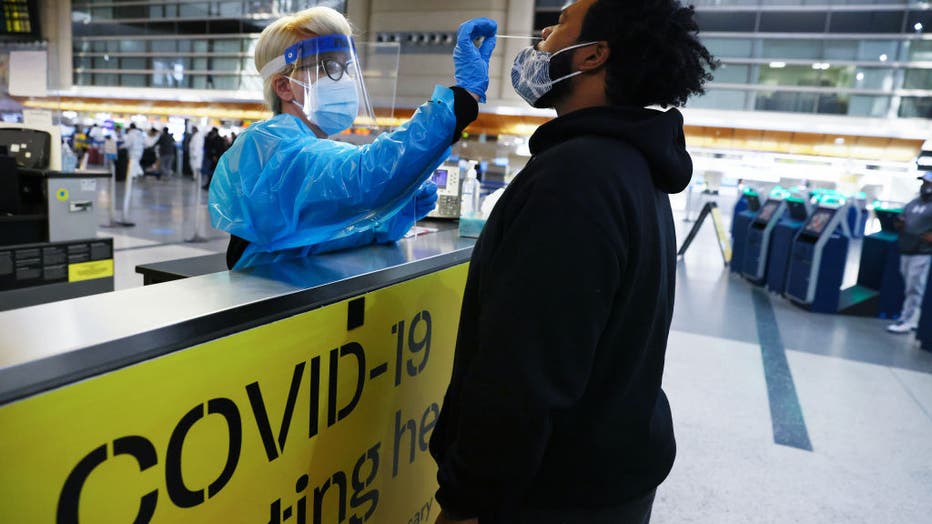WHO experts issue final report on COVID-19’s origin

COVID.gov replaced with 'lab leak' explainer
A federal website that used to feature information on vaccines, testing, and treatment for COVID-19 has been transformed into a page supporting the theory that the pandemic originated with a lab leak. LiveNOW's Austin Westfall breaks it down with infectious disease expert Dr. Peter Chin-Hong.
LOS ANGELES - After more than three years of research and debate, a World Health Organization-appointed group of experts says the question of how COVID-19 began remains unresolved. The group released its final report Friday, citing a lack of access to critical data—particularly from China—as the main reason for its inconclusive findings.
While most available scientific evidence still supports the theory that the virus originated in animals and jumped to humans, the group said it was not able to investigate or rule out a lab-related origin due to missing information. Without access to hundreds of viral genetic sequences and detailed biosecurity data from China, the group could not come to a consensus.
What does the WHO report say about COVID’s origin?
What we know:
Dr. Marietjie Venter, chair of the WHO’s Scientific Advisory Group for the Origins of Novel Pathogens (SAGO), said the majority of scientific data points to a zoonotic spillover—meaning the virus likely spread from animals, possibly bats, to humans via an intermediate host.
There is no evidence COVID-19 was intentionally engineered or that the virus was circulating outside China before December 2019.
In September, scientists narrowed down a list of possible intermediary animals to include raccoon dogs, civet cats, and bamboo rats—species known to be susceptible to coronaviruses.
What we don't know:
Despite repeated requests to Chinese authorities, the WHO group said it was denied access to key data that might have confirmed or ruled out a lab accident. That included biosecurity records and viral sequences from early Wuhan cases.
Because of this, the group could not thoroughly evaluate the lab leak theory. Venter said the theory remains speculative and politicized, and "not backed up by science"—but emphasized that it cannot be excluded either.
What happened during the investigation?
Timeline:
The investigation unfolded over several years, with key milestones reflecting both scientific efforts and political roadblocks.
- 2021: WHO’s initial origin study said a lab leak was "extremely unlikely," favoring a natural origin.
- 2022–2024: The newly formed SAGO group continued the probe but faced ongoing challenges accessing data.
- 2025: On June 27, the final report was released. One member had resigned earlier in the week, and three others asked to have their names removed.
What they're saying:
WHO Director-General Tedros Adhanom Ghebreyesus called it a "moral imperative" to uncover the origin of the virus, citing the more than 20 million deaths and trillions of dollars in global economic losses.

A healthcare worker administers a COVID-19 test at a U.S. airport testing site. A new report from WHO experts says the origin of the virus remains inconclusive, more than three years after the pandemic began. (Photo by Mario Tama/Getty Images)
The Chinese government has consistently denied the possibility of a lab leak and suggested that the search for the origin should extend to other countries.
U.S. President Donald Trump has long argued the virus came from a lab accident in China. However, a U.S. intelligence assessment concluded there is insufficient evidence to prove that theory.
What's next:
With WHO’s official investigation now closed, further answers may depend on the willingness of countries to share data and cooperate with international experts. Independent research into viral origins is expected to continue, especially as surveillance expands to track future outbreaks.
Calls for increased transparency in global health data sharing are likely to grow, especially given the political tensions that shaped the COVID-19 origins debate.
The Source: This article is based on reporting from the Associated Press and the final report issued by the World Health Organization’s Scientific Advisory Group for the Origins of Novel Pathogens. Additional information comes from WHO press briefings and prior investigative coverage by the AP on early Chinese responses to the pandemic.

